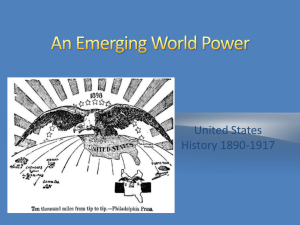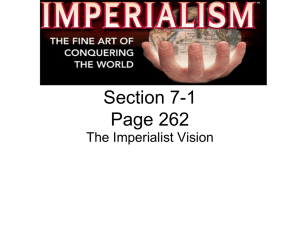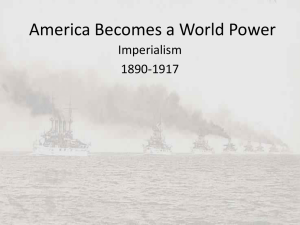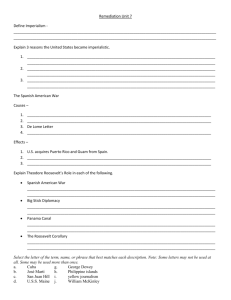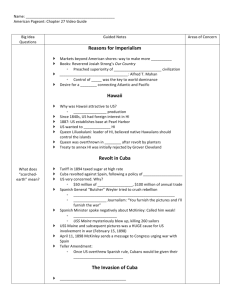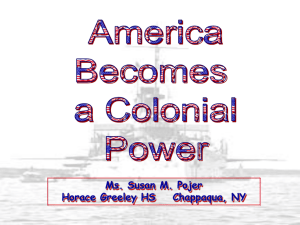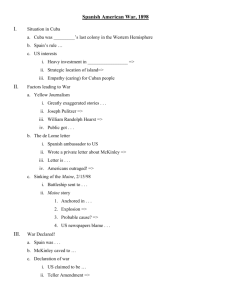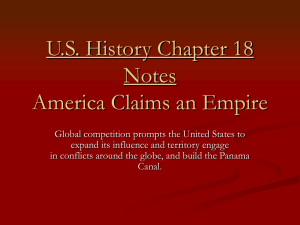American Imperialism Expansionism 1867-1914
advertisement
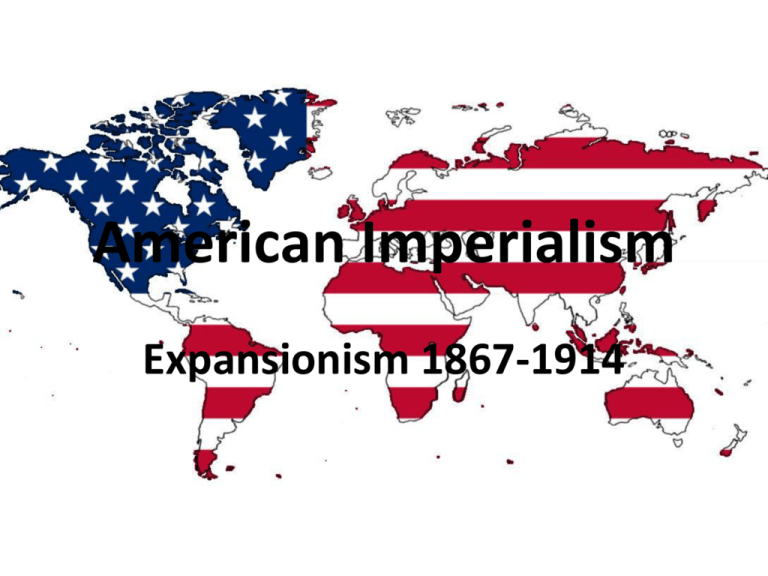
American Imperialism Expansionism 1867-1914 Reasons for Expansion • Global Economic Competition- need for colonies and places for new investment. • Security Needs- need for Panama Canal, Hawaii, and a Caribbean island. • Need for Resources • Depression of 1893- War was a diversion. • Industrialization- created a need for more markets. • Scientific Racism/Eugenics- served as a justification. • White Man’s BurdenCivilize and Christianize. • World Power- desire for military strength. • Nationalism and Jingoism Terms • Imperialism- policy in which stronger nations exert their control militarily, politically, or economically over weaker territories. • Expansionismincreasing the size of a nation’s territory. • Nationalism- a devotion to the interest and culture of one’s nation. • Interventionism- one nation interfering in the affairs of another to pursue their interests. Interventionism • Open Door Policy (1900)- First used in China. Guarantee of equal trading opportunities while protecting the territorial integrity of China. Later applied to other parts of the world. • Lodge Corollary (1912)- First used in Mexico when they tried to sell part of Baja California to Japan. It prevented Latin American countries from selling any of their land to non-European countries. • Roosevelt Corollary (1903)First used in Venezuela. U.S. claimed that it had the right and obligation to militarily intervene under the Monroe Doctrine in any nation in the Western Hemisphere that appeared politically or financially unstable to withstand European control; enforcement mechanism of the Monroe Doctrine. Leadership “Architects of Empire” • William Henry Sewardengineered purchase of Alaska in 1867 and the acquisition of Midway Island. As Secretary of State he argued that due technology, the world was becoming smaller and more dangerous. Therefore, it could no longer depend on oceans for security. • Alfred T. Mahan- He wrote The Influence of Sea Power on History. He argued nations must expand or die; the key to expansion was naval power. He promoted the Great White Fleet because the U.S. needed colonies. • James “Jingo Jim” Blaine- promoted PanAmericanism; U.S. must resolve trade debt with Latin America and get them to buy from us. • Josiah Strong- wrote Our Country (1885). He argued whites are superior to other races. His book served as justification for American actions. • Frederick Jackson Turner- wrote The Closing of the American Frontier (1893). Produced concerns of loss of opportunities and the impact on democracy and the American character. • Sanford Dole- first and only president of the Republic of Hawaii. Helped to secure annexation in 1898. • Theodore Roosevelt- as President provided national leadership; saw the importance of the Pacific to American interests. With the Roosevelt Corollary, the U.S. became “policeman of the Western Hemisphere.” • Henry Cabot Lodgebelieved in American superiority and the right for America to engage in conquest and expand. Key figure in annexation of Philippines and defeat of U.S. in League of Nations. He was responsible for the Lodge Corollary. • John Hay- author of Open Door Policy (1900); opened Chinese treaty ports to equal trading for all nations while preserving Chinese territorial integrity. U.S. acquires Alaska • William Seward, Sec. of State under Lincoln and Johnson, bought Alaska from Russia for $7.2 million in 1867. At the time known as “Seward’s Folly,” Alaska turned out to be rich in timber, minerals, and oil. U.S. takes Hawaii • White sugar plantations accounted for most of Hawaii's wealth in the late 19th century. • They called for the U.S. to annex Hawaii. • In 1887 the U.S. pressure Hawaii to let them build a naval base in Pearl Harbor. • Business groups organized a revolution and with the help of the marines, overthrew Queen Liliuokalani and set up a government headed by Sanford Dole. • In 1898 Congress proclaimed Hawaii an American territory without the Hawaiian's consent. In 1959 Hawaii became the 50th state. Spanish-American War • Cuban Revolution (1895-1898)- America had wanted to buy Cuba from Spain were refused. America invested heavily in Cuba’s sugar cane plantations. In 1895 José Martí led a revolution • 1896 Spain sent General Weyler to Cuba to restore order. • He put over 300,000 people into concentration camps where thousands died. • Newspapers wars between William Randolph Hearst and Joseph Pulitzer were fueled by the coverage of Cuba. • Yellow Journalismsensational style of writing which exaggerates the news to lure and enrage readers. • De Lome letter- letter from Spanish ambassador to the U.S. that criticized Pres. McKinley and called him “weak” was leaked. Americans were angered by the insult to their President. • A few days after the letter, McKinley ordered the U.S.S. Maine to Cuba to bring home U.S. citizens and protect American property. On Feb. 15, 1898, the ship blew up in Havana harbor. • The newspapers blamed Spain and the rallying cry became “Remember the Maine!” • On April 20, 1898, the U.S. declared war on Spain. • The U.S. Navy steamed to the Philippines and conquered the Spanish there. • Cuba was invaded in June 1898 U.S. troops including the Rough Riders, a volunteer cavalry under the command of Theodore Roosevelt. • They were part of the Battle of San Juan Hill. • The U.S. defeated the Spanish in Cuba and then invaded Puerto Rico on July 25. • Treaty of Paris- signed in 1898. Spain freed Cuba and turned Puerto Rico and Guam over to the U.S. The U.S. bought the Philippines from Spain for $20 million. • The United States now had an empire. After the War • Puerto Rico- in 1901 in the Insular Cases, the Supreme Court ruled that the Constitution did not apply to acquired territories. However, Congress granted citizenship to Puerto Ricans in 1917. • Cuba- Independent but occupied by U.S. troops, Cuba was forced to add the Platt Amendment to its constitution. This included the right of the U.S. to intervene in Cuba and buy land for military bases. • Philippines- led by Emilio Aguinaldo, the Filipinos wanted independence and revolted in 1899. U.S. put hundreds of thousands of Filipinos into concentration camps. After three years, $400 million, 20,000 dead Filipinos and 4,000 dead Americans, the rebellion was put down. The Philippines became independent in 1946. • China- the Open Door Policy left China it’s freedom but gave trading rights to all of the imperialist powers. Chinese resentment simmered and secret societies formed. • Boxer Rebellion- martial arts secret society that killed hundreds of foreigners fought against 2,500 troops from U.S., Britain, France, Germany, and Japan. The rebellion was put down in two months after the death of thousands of Chinese. Panama Canal The U.S. wanted the canal to reduce the travel time for commercial and military shipping. Colombia controlled Panama and would not allow the canal. So a Panamanian rebellion was organized against Colombia in 1903 by the U.S. After Panama declared its independence the U.S. signed a treaty to build the canal and rented the area, the Canal Zone. It opened in 1914. Foreign Policy- Methods of Imperialism • Protectorate/Gunboat Diplomacy- spheres of influence and protectorates. (Roosevelt) • Dollar Diplomacyinternational loans and investments in 3rd world countries. (Taft) • Moral Diplomacydiplomatic pressure to democratize. (Wilson) Mexican Revolution 1911-17 • Watchful waiting policy Pancho Villa
